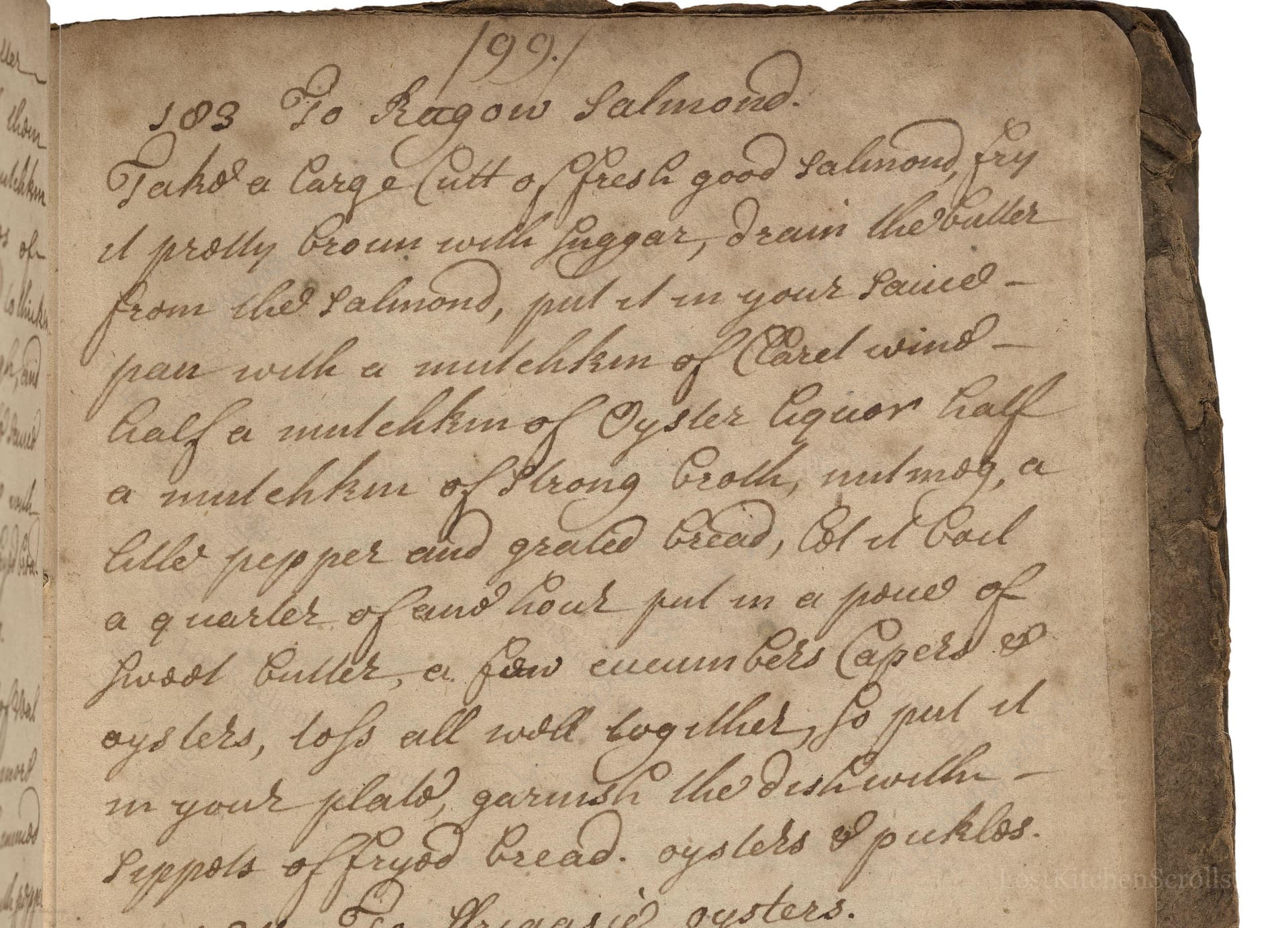To Ragow Salmond
From the treasured pages of Receipts for cookery and pastry work
Written by Mrs. Johnston

To Ragow Salmond
"Take a Large Cutt of Fresh good Salmond & fry it pretty Brown with suggar, Drain the Butter from the Salmond, put it in your sauce-pan with a mutchkin of Claret wine half a mutchkin of Oyster Liquor half a mutchkin of Strong Broth, nutmeg, a litle pepper and grated Bread, boil it half a quarter of and hour, put in a peice of fresh Butter, a few cucumbers Capers & oysters, toss all well together So put it in your plate & garnish the dish with sippets of fry'd Bread. oysters & pickles."
Note on the Original Text
Early 18th-century recipes like this were written for reasonably experienced cooks, often female heads of household or their staff. The style is brief, omits quantities unless essential, and jumps logically from step to step, trusting the reader's knowledge. Spellings like 'Ragow' (ragout), 'suggarr' (sugar), 'mutchkin' (a Scottish liquid measure of about 425ml), and 'sippets' (bread shapes) reflect regional dialect and period conventions. Directions are sequential but conversational, blending culinary intuition with practical know-how.

Title
Receipts for cookery and pastry work (1700)
You can also click the book image above to peruse the original tome
Writer
Mrs. Johnston
Era
1700
Publisher
Unknown
Background
A delightful compilation of 18th-century recipes gathered by Mrs. Johnston herself, promising a charming journey through the flavors and culinary traditions of the early 1700s.
Kindly made available by
Folger Shakespeare Library
This recipe comes from a handwritten manuscript compiled by Mrs. Johnston around 1700—an age where British cuisine was embracing global influences, a little luxury, and plenty of wine in their fish dishes. The combination of claret, oyster liquor, and strong broth signals a taste for bold, hearty flavors often found in the kitchens of the well-to-do. Pickles, capers, and sugared frying gave familiar ingredients a sophisticated, almost continental edge, reflecting both the rich resources and the adventurous palates of the time.

A heavy frying pan (likely cast iron or brass) was used for browning the salmon, while a deep saucepan or stewpan handled the simmering of the flavorful sauce. A sharp knife for slicing bread and vegetables, a ladle for handling hot liquids, and tongs or a fork for turning the fish were all common. An open hearth, trivet, or range would have provided the heat, and bread sippets would be fried in rendered fat or butter in a small pan or skillet.
Prep Time
15 mins
Cook Time
20 mins
Servings
4
We've done our best to adapt this historical recipe for modern kitchens, but some details may still need refinement. We warmly welcome feedback from fellow cooks and culinary historians — your insights support the entire community!
Ingredients
- 1 lb fresh salmon fillet
- 1 oz butter
- 1 tablespoon sugar
- 1 1/4 cups claret red wine (or any dry red wine)
- 2/3 cup oyster liquor (substitute: clam juice or light fish stock)
- 2/3 cup strong fish or chicken broth
- grated nutmeg (to taste, about 1/4 teaspoon)
- black pepper (to taste)
- 2 tablespoons fine breadcrumbs
- 2 tablespoons fresh butter (for finishing, about 1 oz)
- 2 oz sliced cucumber
- 1 tablespoon capers
- 6-8 fresh or preserved oysters, shelled
- fried bread sippets (small triangles of bread)
- additional oysters and mixed pickles for garnish
Instructions
- Begin by taking a generous cut (about 1 lb) of the freshest salmon you can find.
- Heat a knob of butter in a frying pan and sprinkle the fish with 1 tablespoon of sugar before frying it on both sides until it develops a rich, caramelized brown crust.
- Drain off the butter, then place the salmon into a saucepan with 1 1/4 cups of claret red wine, 2/3 cup of oyster brine (reserved from a jar of oysters or substitute with clam juice), and 2/3 cup of strong fish or chicken stock.
- Add a good pinsh of grated nutmeg, a little black pepper, and about 2 tablespoons of fine breadcrumbs for body.
- Simmer gently for about 7 minutes.
- Stir in 2 tablespoons (about 1 oz) of cold, fresh butter along with a handful of sliced cucumber (about 2 oz), 1 tablespoon of capers, and 6-8 shelled oysters (fresh or preserved).
- Swril or gently toss to combine and heat through.
- Serve the salmon and its sauce on a plate, garnishing with crispy fried bread sippets (small triangles of bread), a few additional oysters, and some mixed pickles for an elegant finish.
Estimated Calories
450 per serving
Cooking Estimates
It takes about 15 minutes to prepare your ingredients and workspace. Cooking takes around 20 minutes, including frying and simmering the salmon. Each serving has about 450 calories, and this recipe serves 4 people.
As noted above, we have made our best effort to translate and adapt this historical recipe for modern kitchens, taking into account ingredients nowadays, cooking techniques, measurements, and so on. However, historical recipes often contain assumptions that require interpretation.
We'd love for anyone to help improve these adaptations. Community contributions are highly welcome. If you have suggestions, corrections, or cooking tips based on your experience with this recipe, please share them below.
Join the Discussion
Rate This Recipe
Dietary Preference
Main Ingredients
Occasions

Den Bockfisch In Einer Fleisch Suppen Zu Kochen
This recipe hails from a German manuscript cookbook compiled in 1696, a time whe...

Die Grieß Nudlen Zumachen
This recipe comes from a rather mysterious manuscript cookbook, penned anonymous...

Ein Boudain
This recipe comes from an anonymous German-language manuscript cookbook from 169...

Ein Gesaltzen Citroni
This recipe, dating from 1696, comes from an extensive anonymous German cookbook...
Browse our complete collection of time-honored recipes



